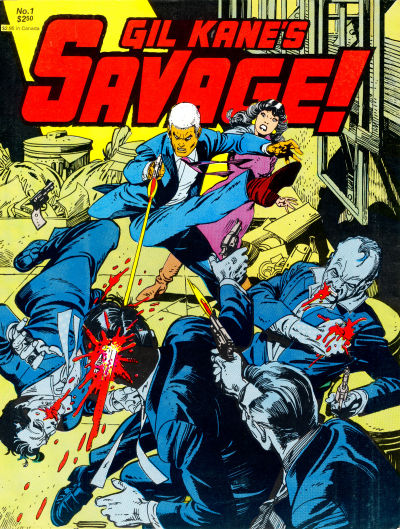Gil Kane’s Savage! lives up to its name from the very cover, with a level of violence not seen in any comic in 1968 and rarely since.

You can tell this is Gil Kane even without this being Gil Kane’s Savage!, can’t you? The elongated figures, the girl’s face, the way the thug on the left is flung back by Savage’s kick, all tell tale signs of Kane’s art.
And yet it’s a Gil Kane comic that’s a very long way away from what he had became known for, when this was first published in 1968. Famous for co-creating the Silver Age versions of the Green Lantern and The Atom, together with Carmine Infantino laying the foundations for the ‘clean’ style of DC’s Silver Age, it turns out from the interview in the back that he had actually become increasingly frustrated by the limitations of working for DC Comics:
When I first started to do Green Lantern and The Atom, they wouldn’t allow me to do more than oen panel of action, of fighting action in a fight. I wasn’t allowed more than one panel in a story. I used to stretch it and squeeze it, move some of the panels together, which was almost sacrilegious, or I would squeeze in another panel on the page in order to accommodate a second punch in the goddamn fight scene.
With Savage Kane got the freedom to show the violence as long and as rough as he wanted to and he took full advantage. The project was all his, an attempt in 1968 to create a new type of comics magazine, not beholden to the Comics Code Authority, something more mature and sophisticated. Kane got Archie Goodwin to write it, based on his breakdowns and after having discussed the plot with him, but this was mostly his creation.
As a story, it’s very of its time, a spy thriller in which Savage has to stop the planned assassination of the US president by Simon Mace, who had been his commander in WWII. Most of the plot involves Savage trying to find Mace before he can execute his plot only to having to fight off his henchmen. There’s of course Mace’s beautiful daughter with whom he is in love and who he has to protect from her own father.

The story therefore isn’t why you read this, it’s Kane’s artwork, the cinematographic quality of it, the way he lets himself loose in it. One interesting choice in this is that most of the texual narration is done via captions, with only a limited amount of text balloons in the art itself, reminiscent of Hal Foster’s Prince Valiant. As Kane himself admits, it’s not always successful, as the captions often describe what is already clear from the drawings, rather than supporting them.
Savage was supposed to become an ongoing series, but in 1968 the market wasn’t ready for it. This reprint by Fantagraphics is from 1982, when Fantagraphics had just started to publish its own comics; the back cover advertises the first Love and Rockets. In magazine format, this reprints not just the original, but adds an essay by R. C. Harvey putting it into context as an early forerunner of what Will Eisner would christen “graphic novels”. There are also two interviews with Kane, one by Gary Groth and Mike Catron on Savage and one by Will Eisner going into Kane’s approach to art. This secondary material makes this even more fascinating: Kane is an intelligent, erudite creator so you get some real insight in why he made Savage what it is. And seeing what he looked like, you can understand where his elongated figures come from in his art: dude looks exactly like his own drawings.
No Comments